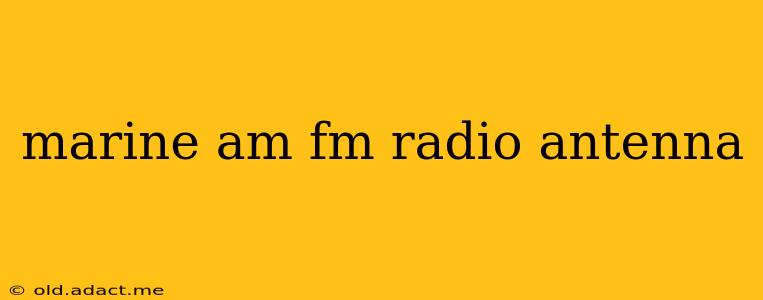Choosing the right marine AM/FM radio antenna can significantly impact your listening experience on the water. A poorly chosen antenna can lead to poor reception, static, and frustration, while a well-chosen one ensures clear, crisp audio, enhancing safety and enjoyment during your boating adventures. This guide delves into the key factors to consider when selecting a marine AM/FM radio antenna, addressing common questions and concerns.
What are the Different Types of Marine AM/FM Antennas?
Several types of marine AM/FM antennas cater to various needs and boat sizes. The most common include:
-
Whip Antennas: These are the most basic and widely used type. They're relatively inexpensive, easy to install, and offer decent performance. Their length is a crucial factor in reception quality, with longer whips generally providing better range.
-
Stainless Steel Antennas: Constructed from durable stainless steel, these antennas offer superior corrosion resistance, ideal for saltwater environments. They often come in various lengths and styles to match different boat aesthetics.
-
Low-Profile Antennas: Designed to minimize height, these antennas are perfect for boats with low clearance or those prioritizing a sleek profile. While offering less range than taller antennas, they are a practical choice for many boaters.
-
AM/FM/TV Combination Antennas: These antennas combine AM/FM radio reception with TV capabilities, ideal for those wanting to receive television broadcasts while underway (though this is less common on modern boats).
How Do I Choose the Right Length for My Marine Antenna?
Antenna length directly impacts reception quality. Generally, longer antennas provide better range, particularly for AM reception. However, excessively long antennas can be cumbersome and may not be suitable for all boats. Consider your boat's size, clearance requirements, and the typical range you require when selecting an antenna length.
What is the Best Placement for a Marine AM/FM Antenna?
Optimal placement maximizes reception and minimizes interference. Ideally, locate the antenna as high as possible and away from obstructions such as metal structures or electronic equipment. The antenna should also be grounded properly to ensure efficient signal reception and minimize electrical noise.
How Do I Install a Marine AM/FM Antenna?
Installation varies depending on the antenna type and boat design. Most installations involve mounting the antenna base securely to the boat's deck or mast using appropriate hardware. Always consult the manufacturer's instructions for detailed installation guidance, and ensure you use the correct sealant to create a waterproof seal.
Can I Use a Standard Car Antenna on My Boat?
While a car antenna might seem like a cost-effective alternative, it's generally not recommended for marine use. Marine antennas are designed to withstand the harsh conditions of saltwater exposure, including UV radiation, moisture, and potential impacts. A standard car antenna is likely to corrode or fail prematurely in a marine environment.
How Much Does a Marine AM/FM Antenna Cost?
Prices range significantly based on the antenna's type, materials, features, and brand. Expect to pay anywhere from a few tens of dollars for a basic whip antenna to several hundred for more sophisticated, durable models. Investing in a quality antenna will usually provide better performance and longevity.
What are the Benefits of a High-Quality Marine AM/FM Antenna?
A high-quality antenna offers superior reception, resulting in clearer audio, reduced static, and improved signal strength, particularly in challenging reception areas. This translates to enhanced listening enjoyment and can also be crucial for receiving weather reports and other important broadcasts related to boating safety. It also usually provides a longer lifespan, thus offering better value in the long run.
This guide provides a comprehensive overview of marine AM/FM radio antennas. Remember to consider your specific needs and boat type before making a purchase. Selecting the right antenna ensures a superior audio experience and contributes significantly to enhancing your boating adventures.
